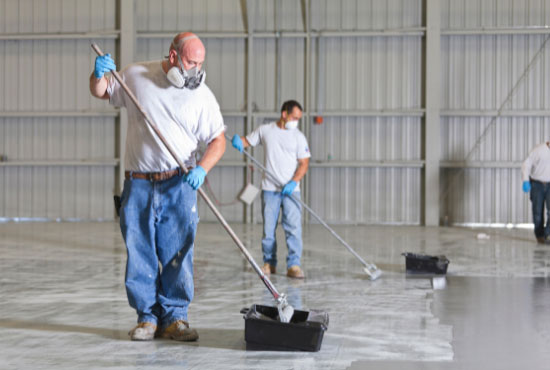One of the problems with painting your deck, your porch, or your floor is you cannot walk on that surface until the paint is dry. Most people who have considered painting these areas have pondered how long floor paint takes to dry. That is totally understandable.
There are different types of floor paint, and the different paint bases, the thicknesses of the paint, the weather conditions, and the material you put the paint on all play a role in determining the length of time it takes for the substance to dry properly.
Is The Paint Dry to The Touch or Cured?

This is the major consideration in floor painting. Understanding the difference will save you heartache and repainting in the future.
Dry to The Touch
When paint starts to dry the solvents in the formula begin to evaporate. As these solvents evaporate the upper section of the paint starts to feel dry. You may even be able to touch the surface with your fingers and no paint is transferred onto your fingers. This is “dry to the touch” and not ready to walk on.
Cured Floor Paint

When the solvents have completely evaporated and the paint has hardened all the way from the top to where it makes contact with the surface, then you have cured paint. You can walk on cured paint and not damage the finish. Cured paint is totally dry.
There is a way to tell if the paint is just dry to the touch, or if it has hardened completely to a full cure. Find a place that is not going to be easily noticed if a small imperfection is made on the painted surface.
Press your fingernail into the paint with slight pressure. If an indention forms, then the paint is not completely cured but if no mark is created the paint is as dry and as hard as it will get.
Floor Paint Drying & Curing Times
Most paint products have a dry time listed on their labels. The dry time they are referring to is dry to the touch time, not the cured-to-perfection time. You can start using some painted surfaces before they reach their full cure, but beware they are susceptible to damage prior to the full cure.
Water-Based Paints

Water-based paints dry to the touch in 2 hours or less, but they need about 21 days to dry to a full hardened cure. This longer drying time is because of the water base. The water does not evaporate as quickly from the substance as the solvents in an oil-based formula do.
Oil-Based Paints
Oil-based paints reach a full cure much faster. They dry to the touch in about 6 hours but they reach a full cure dry in about 3 days. Oil-based paints are typically preferred for exterior use because they cure more quickly, they are resistant to weather conditions like rain and humidity, and they are tough and durable.
Valspar Porch and Floor Paint Dry Time

Valspar Porch and Floor are one of the few paints intended for floor painting that give you a reasonable dry time. This particular brand of paint tells you to refrain from making a second coat, or from walking on the surface until at least 24 hours have passed. The label tells you that it can take as long as 72 hours for the paint to reach dry to the touch.
In the 24-hour period, your Valspar porch and floor paint will not have reached a full cure but it will have hardened enough that you can re-paint or walk on it lightly. Do not move furniture and keep the traffic on the floor as low as possible until at least three days have passed. After 3 – 7 days, depending on how thick the paint coatings are and what the weather temperature is, the paint should have reached the perfect cure and be ready for life as normal at your home.
Things That Influence the Drying Time
There are several factors that cause the paint to dry faster or take longer to dry.
- Humidity – High levels of humidity will slow the evaporation process and cause the paint to dry slower.
- Cold temperatures – when the temperatures are cooler, then the evaporation is slower. Between 500 and 900 is the perfect painting temperature.
- Surface materials such as plastic, wood, and concrete, will dry at different rates.
- The thickness of the paint applications will affect the drying time. Valspar Porch and floor recommends two coats of paint, as most floor paints do. If spraying with a paint sprayer they suggest the first coat be thinned using one pint of water for each gallon of paint, and the second coat is applied without thinning. This creates uniform and consistent coverage.
Final Thoughts
When painting an area that is walked on always let it reach a cure before you start traveling across it. Use other entranceways, or do this kind of painting when fewer people will be at the home. You can even paint before you leave for a weekend trip, so the paint has time to cure while you do not need to walk on the surface.
Read More:
1. Why Do Painters Wear White?
2. How to Remove Painters Tape
